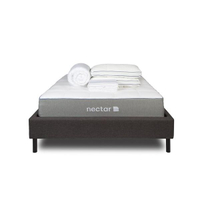How to use the body scan meditation technique for sleep
Get mindful and fall asleep faster with the body scan technique for sleep

If you have trouble falling asleep, a body scan meditation might be the answer you're looking for. Not only is this method easy to do, but it is completely natural and could have a positive impact on your waking day too.
In this article, we explore exactly what the body scan technique for sleep is and explain how to do it, step-by-step, to help you get the slumber you deserve. We'll also look at what are the benefits of a body scan and how long it will take until you are blissfully snoozing away.
What is the body scan meditation technique?
In a nutshell, the body scan meditation is a self-guided technique that helps release tension in the body. It is based on the practice of mindfulness and comes with backing from scientific studies. It can be used at any time of day, but is particularly useful to help you relax ready to sleep.
The technique involves holding attention on different parts of the body one at a time from head to toe, focusing on sensations and letting go of tension. Over time, and with a little practice, this will relax the body, allowing you to fall asleep more easily.
When used as a part of a bedtime wind-down routine, it can be even more effective, so remember to cut down on the caffeine after lunchtime, switch the screens off an hour or two before bedtime and avoid alcohol at night too – all things that can promote better sleep. (The 10-3-2-1-0 sleep rule can help bring structure to this.)
How can body scanning help with sleep?
Elevated stress levels during the day can affect the quality of sleep you get at night, and vice versa. If you're up till the small hours worrying, then this could lead to fewer hours' sleep and diminished focus and more fatigue the next day – it's a vicious circle. But the research behind mindfulness showed that adults who performed a body scan on a regular basis began to notice a greater sense of psychological wellbeing, an increased capacity to deal with stress, and lowering levels of depression, all of which helps improve the quality of sleep.

How to do a body scan meditation
Performing the body scan technique for sleep is very straightforward. Here's a step-by-step guide (if you prefer to follow a video, scroll down for two useful ones):
Sign up to get the BEST of Tom's Guide direct to your inbox.
Get instant access to breaking news, the hottest reviews, great deals and helpful tips.
1. Prepare yourself
First, make sure you are comfortably lying down or seated so that your limbs can be stretched out. With your eyes closed, begin by taking a few deep breaths. Now as your breathing settles, pay attention to the natural rhythm of your inhalations and exhalations.
2. 'Scan' your head
Gently bring awareness to the top of your head, maintaining a slow and steady breath. Try to notice any sensations as you breathe. Does your head feel tight or stressed? Without judgement, let any thoughts pass and focus on the sensations instead. As you breathe, allow any tension to dissolve, and let your head feel more relaxed. Hold the attention for a few seconds or one minute, whatever it takes for you to feel the tension releasing.
When you feel ready, soften the focus on the head and move your attention to your face. Continue breathing, noticing the sensations as you did before, and gradually let any tension go.
Remember to let any anxious thoughts pass and bring your attention back to your breathing and the sensation in your body.
3. Move on to the rest of your body
Repeat the steps – gently holding focus, breathing, softening – as you continue down the body. Move to the neck and throat, the shoulders, left arm, left hand, right arm, right hand, the back, the torso, left leg, left foot, right leg and right foot. Over time you will find a routine that intuitively works for you. Some people start the body scan at the hands, while others start with their back.
If you're still feeling tense after the first round of the body scan, then repeat the process until you are more relaxed and ready to gently drift off to sleep.
Body scan meditation videos
If you prefer to be guided through the body scan, Jon Kabat-Zinn, the creator of the Mindfulness-Based Stress Reduction program, has created an excellent 30-minute routine that can help you get started. Watch it below.
If you are very short on time, even three minutes a day will soon see an improvement. Try this super-short three-minute version by UCLA's Mindful Awareness Research Center.
How long should a body scan take and how often should I do it?
How long the body scan takes depends on what your mind and body needs. The routine can take as little as 60 seconds or up to 40 minutes. With practice, you'll be able to find what works best for you.
However, the key is to get into a regular habit – therefore a few minutes a day is better than not at all. You might not notice much difference to start with, but, over time, the effects will build up to help not only improve sleep, but reduce anxiety, improve focus and increase self-compassion too. Studies have also found mindful breathing and the body scan technique can help with the symptoms of PTSD and depression for certain individuals.
If the body scan technique isn't working for you for whatever reason, some experts recommend getting out of bed and doing something relaxing rather than stressing about not being able to drop off – this is known as the 15 minute sleep rule.
Nectar mattress: was $599 now $359 at Nectar
The Nectar Sleep Awareness Week sale knocks 33% off everything. Our favorite is the original model – in our Nectar mattress review, we found it to be a versatile all-foam mattress that would suit a wide range of people and any sleep position. With 33% off, a queen size is $699, which is excellent value for our favorite memory foam mattress.
This article is part of Tom’s Guide’s Sleep Week 2023 celebration, running from Sunday 12 - Saturday 18 March. Over the course of the week we'll be bringing you plenty of expert sleep tips and techniques to help you sleep better this year, as well as advice to help you build the perfect sleep setup for you.
Grace is an experienced sleep writer and mattress reviewer who also contributes to our sister site TechRadar, among other Future plc brands. She's a big fan of organic sleep products and has recently invested in a wool mattress topper that she quite happily describes as "life-changing." (Hey, we're serious about our sleep products). When she isn't testing mattresses or writing about sleep, Grace enjoys reading and creative writing, and incorporates meditation and yoga into her wellness routine.




